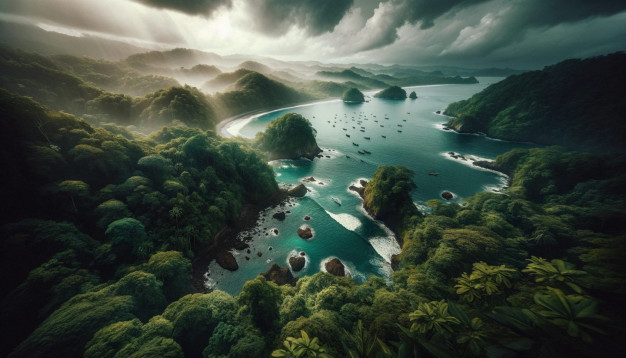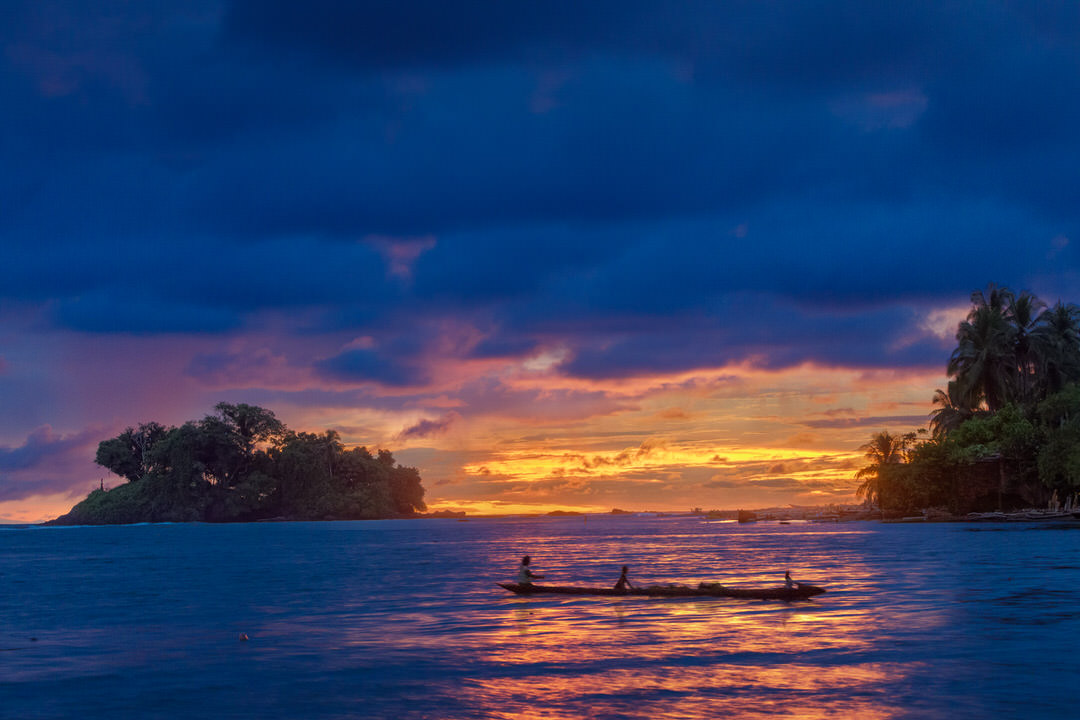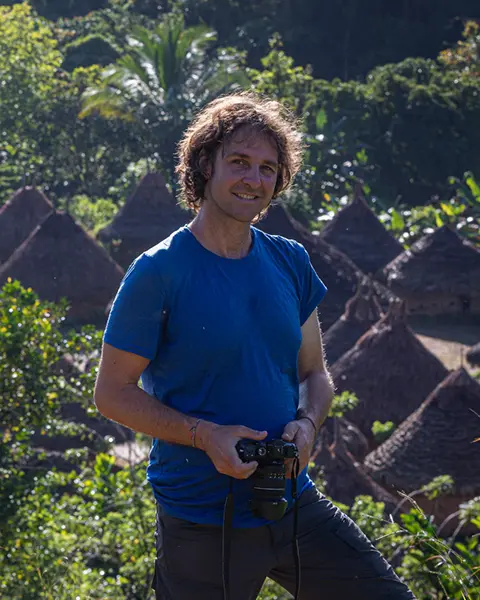
Things to do in Bahía Solano & Nuqui
Some jungles and beaches, not yet discovered, offer the most exotic flora and fauna of the tropics. The physical characteristics and geographic location are used to develop activities in nature with conservation parameters that help education and environmental awareness. With its National Natural Parks, the visit of humpback whales, turtle nesting, the passage of migratory birds, apart from the immense native natural wealth, both in the sea and on land, this region has been catalogued as a tourist potential for all seasons of the year.

Sun and Beach
One of its natural attractions are the peaceful and extensive beaches and cliffs framed between the Choco jungle and the Pacific and Atlantic oceans. Each beach is crossed by streams of crystalline waters that feed the sea and create a relaxing atmosphere.
Surf, sports & adventure
The Chocó has great tourist attractions such as the marine world, jungle trails, surrounded by giant trees and crystalline waterfalls; imposing canyons, countless rivers and streams, spectacular natural pools, rich thermal waters and countless unspoiled places, especially for sports activities. Its marine area facilitates the practice of diving, fishing of all modalities, surfing, kayaking, snorkeling and trekking, among others.
Whale wathcing & Wildlife
The Chocó rainforest is one of the richest in the world in terms of flora and fauna species. Its botanical splendor has been recognized by great scientists of the world who have found in its jungles a variety of species. In addition to its flora, the fauna of Chocó is impacted by the passage of humpback whales, sea turtles and large birds that provide impressive spectacles at certain times of the year. One of the greatest strengths of Chocó’s tourist destinations is the warmth of its people.
The Nature of Chocó
The Pacific ecoregion is a biogeographic formation that begins in Panama and reaches the north of Ecuador. It is characterized by its high biodiversity, endemism and beauty in a context in which colonization and timber exploitation are advancing, which is why it has been catalogued as one of the most threatened areas in the world.
The forests of Chocó are famous for their biodiversity. There are more than 9000 species of vascular plants, about a quarter of them endemic. The Chocó has a great variety of animals, some of them endangered. Among them are mammals: tamandua, species of anteater, sloth bear, ocelot, jaguarundi, species of puma, howler monkey, and armadillo; birds: chabarri, kingfisher, green kingfisher, churrinche, pepite or suirirí, azulejo or tangara azuleja and guaco; green iguana, lizards, snakes and turtles; and amphibians: frogs of various species.
The volcanic nature and certain erosive processes have created spectacular underwater landscapes with coral formations where many marine species live such as white shrimp, piangua, crab, oysters, starfish, hammerhead sharks and a multiplicity of fish. It is also a mating place for humpback whales, which can reach up to 15 meters in length.
The Playón and La Playona beaches, in the municipality of Acandí, hold the densest population of loggerhead turtles in the Colombian Caribbean – the largest turtle in the world – and are the most suitable places for nesting.
Best time to travel to Nuqui & Bahia Solano
In general terms, you can travel to Chocó at any time of the year, considering these two aspects:
– The first three months of the year are the driest time of the year, and October is the wettest time.
- Between July and October is the whale season in the Pacific Ocean.
Recommendations for travel to Nuqui & Bahia Solano
Whoever wishes to travel to Chocó with the purpose of finding attractions very different from those conventionally offered by other regions of Colombia, America and the world, should take into account the following:
- The main tourist sites in Chocó have hotels, lodges, hostels and inns. In the beach and jungle areas there are ecolodges and tourist inns in the municipalities of [Bahía Solano] and its jurisdiction El Valle, Playa Huina, Playa Potes and Playa Flores, and Nuquí and its jurisdiction Guachalito, Coquí, Joví, Termales and Morrorrico.
- Please note that the total weight of baggage allowed as cargo on small aircraft must not exceed 10 kilograms.
- Upon arrival, don’t forget to confirm your return flight.
- Flights are often delayed of 1 day due to weather conditions and heavy rains, so it is not recommended to take any other flight connection in the same day.
- When buying handicrafts, pay a fair price for the pieces you are buying; this helps local communities and their livelihoods.
- Some indigenous people may be upset if you photograph them, it is best to get their permission and talk to them.
- It is forbidden to drink liquor, throw food into the sea or any other element outside the boat.
- If the clothes were wetted with sea water, the humidity of the environment will prevent them from drying. If washed with fresh water, the problem is solved.
- If you are going to take surf lessons for the first time in Chocó, you may not know that you have to wear a t-shirt or wet suit, so as not to hurt your belly with the taba.
How to get around in Chocó
The most common means of transportation in the department of Chocó is by water, either river or sea. This type of transportation is more important than anywhere else in Colombia. Chocó moves along the Caribbean Sea and the Pacific and, in the center of the department, through its main fluvial arteries, the Atrato and San Juan rivers and their innumerable tributaries.
In Quibdó and its surroundings there are some highways and secondary roads that connect with several tourist destinations not far from Quibdó. Some of these roads are in the process of being upgraded.
Transportation
Buses and cabs operate in Quibdó, the capital. In Bahía Solano and several municipalities there are motorized tricycles known as rapitaxis, used for trips within the urban perimeter and trips to the airport and to the village of El Valle, where a small car route is also established. The most important vehicles for water transport are small boats with outboard motors that travel along rivers. There are specific routes with regulated frequencies between the two places.
What to bring when traveling to Nuqui & Bahia Solano
- Carry painkillers and first aid kits in your luggage.
- Resealable bags for storing electronic equipment (cell phones, cameras, etc.) to prevent moisture from damaging them.
- Carry a raincoat in case the rain comes in the middle of a hike.
- Comfortable backpack to keep your hands free. In addition, the backpack fits easily into the storage space of small boats.
- Rubber boots and sturdy or sports shoes that protect the ankles.
- Cotton clothing, bathing suit, long pants and long sleeve t-shirt to protect you from insects and branches that can hurt you.
- Hat, cap or cap, sunglasses and light raincoat (rains are quite frequent).
- Personal use products such as insect repellent and soaps made from biodegradable concentrates. Detergents, soaps or harmful substances thrown into water sources and watercourses are pollutants.
- Identity card and current health service card.
- It is essential at all times to use sunscreen that does not pollute the ozone layer.
- Constant hydration is important as there is high humidity. Bring your own thermos preferably.
- Yellow fever vaccine (not mandatory).
- Wear comfortable shoes with good grip.
- Cash, preferably in low denomination bills.
National Parks in Chocó, Colombia
In the department of Chocó there are three national natural parks: (PNN) Utría included between the jurisdictions of the municipalities of Bahía Solano and Nuquí, (PNN) Los Katíos which is part of the Darién Gap, one of the places in the world with the greatest water wealth, located within the jurisdictions of the municipalities of Riosucio (Chocó) and Turbo (Antioquia); and
Tatamá (PNN), which is located in the municipalities of San José de Palmar, Novita, Santa Rita de Iró and Tadó, in Chocó, and some towns in Valle del Cauca and Risaralda.
- Playón and Playona Wildlife Sanctuary
- Los Katíos National Park
- Ensenada de Utría National Park
The Playón and La Playona beaches, in the municipality of Acandí, hold the densest population of loggerhead turtles in the Colombian Caribbean.
The 14 km long Playón y Playona beach, also known as Playón y Playona Sanctuary, or Playa Caná, is considered a sanctuary for the preservation of the Caná sea turtles, which come to lay their eggs once a year, at Easter time. Playona is the fifth most important beach in the world for the conservation of this species of sea turtle, which is the largest in the world, measuring up to 2 m in length.
How to get to the Department of Chocó
Depending on the region and the tourist destination to be visited in the department of Chocó, the following alternatives are available:
By air
It is the fastest way to reach the department and communicate from Quibdó directly to Bahía Solano, Acandí, Capurganá and Nuquí. There are different companies that provide the service in small aircrafts. Quibdó’s El Caraño airport is the main air base that connects the department with the country’s main cities.
By land
As a jungle region with high rainfall, the department lacks extensive road infrastructure.
So it is impossible to get to Nuqui or Bahia Solano by land.
Getting to Quibdo
The main roads are the following:
- Via Medellín: Bogotá-Medellín-Bolívar (Antioquia)-La Mansa-El 7-El Carmen-El 12-El 18-Tutunendo-Quibdó.
- Via Pereira: Bogotá-Pereira-La Virginia (Caldas)- Apia-Pueblo Rico-Santa Cecilia-Tadó- Animas-Certegui-Yuto-Quibdó.
- Via Pereira: Bogotá-Pereira-La Virginia (Caldas)- Apia-Pueblo Rico-Santa Cecilia-Tadó- Animas-Certegui-Yuto-Quibdó.
Getting to Acandi
- For Acandí and its villages and hamlets there is a maritime connection in the cities of Turbo, municipality of Antioquia, and occasionally in Necoclí, department of Antioquia.
By water
The department’s maritime routes and river interconnection facilitate access and transportation.

At the helm of Remote Expeditions, Tristan adeptly combines exploration, photography, tour design, web development, and tour leadership, encapsulating the essence of a versatile travel entrepreneur. His mission is to offer a limited number of high-quality tours each year, ensuring an unparalleled travel experience steering clear of mass tourism. He aims to guide you towards the true essence of each destination, facilitating a deep connection with both nature and yourself.